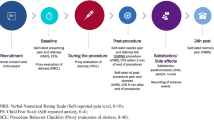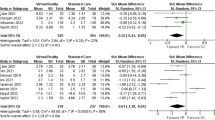Abstract
This study sought to determine whether adding virtual reality (VR) was superior to standard of care alone in facilitating reduction in pain and anxiety among children who underwent intravenous catheterization in the emergency department (ED). Sixty-six children aged 6–16 years who needed intravenous placement received VR, or standard of care in the ED (videos, television, iPad, child life specialist). Outcome measures included change in pain score, level of anxiety, patient and parent satisfaction (pain and anxiety), number of trials, and procedure time. Compared with controls, the intervention group had similar age, sex, number of trials, and anesthetic use. Time of procedure was shorter in the VR group (median 5 min) but this was not statistically significant compared with 7 min for the control group. Pain in the intervention group was lower, even before the procedure. Difference in pain (before and after) and anxiety (after the procedure) were similar in both groups. Satisfaction from anxiety management was higher for the VR group (p < 0.007) and children rated VR significantly more “fun” (p < 0.024).
Conclusion: VR was an effective distraction tool and increased satisfaction from anxiety management for this common pediatric procedure, and should be incorporated in management of anxiety in children in the ED setting.
Trial registration: clinicaltrials.gov ID NCT03681730, https://clinicaltrials.gov/ct2/show/NCT03681730
What is Known: • Virtual reality is an evolving computer technology that shows some promise in the areas of acute and chronic pain management due to its ability to create effective distraction. | |
What is New: • We report that among children in the emergency setting with intravenous catheterization, satisfaction from the use of VR for anxiety management should support implementation of VR systems for this procedure |

Similar content being viewed by others
Abbreviations
- CAS:
-
Colored Analogue Scale
- ED:
-
Emergency department
- EMLA:
-
Eutectic Mixture of Local Anesthetics
- FPS-R:
-
Faces Pain Scale – Revised
- IRB:
-
Institutional Review Board
- IQR:
-
Interquartile range
- IV:
-
Intravenous catheter
- VR:
-
Virtual reality
- VAS:
-
Visual Analogue Scale
References
Catudal JP (1999) Pediatric IV therapy: actual practice. J Assoc Vasc Access 4(1):27–29. https://doi.org/10.2309/108300899775703652
Birnie KA, Noel M, Chambers CT, Uman LS, Parker JA (2018) Psychological interventions for needle-related procedural pain and distress in children and adolescents Cochrane Database Syst Rev 10. https://doi.org/10.1002/14651858.CD005179.pub4
MacLean SBA, Obsipo J, Young KD (2007) The gap between pediatric emergency department procedural pain management treatments available and actual practice. Pediatr Emerg Care 23(2):87–93. https://doi.org/10.1097/PEC.0b013e31803
Olsen K, Weinberg E (2017) Pain-less practice: techniques to reduce procedural pain and anxiety in pediatric acute care. Clin Pediatr Emerg Med 18(1):32–41. https://doi.org/10.1016/j.cpem.2017.01.007
Zempsky WT, Cravero JP (2004) Relief of pain and anxiety in pediatric patients in emergency medical systems. Pediatrics 114(5):1348–1356. https://doi.org/10.1542/peds.2004-1752
Arane K, Behboudi A, Goldman RD (2017) Virtual reality for pain and anxiety management in children. Can Fam Physician 63(12):932–934
Hoffman HG, Chambers GT, Meyer WJ 3rd, Arceneaux LL, Russell WJ, Seibel EJ, Richards TL, Sharar SR, Patterson DR (2011) Virtual reality as an adjunctive non-pharmacologic analgesic for acute burn pain during medical procedures. Ann Behav Med 41(2):183–191. https://doi.org/10.1007/s12160-010-9248-7
Hoffman HG, Richards TL, Coda B, Bills AR, Blough D, Richards AL, Sharar SR (2004) Modulation of thermal pain-related brain activity with virtual reality: evidence from fMRI. Neuroreport 25(7):2013–2014. https://doi.org/10.1097/01.wnr.0000127826.73576.91
Pryszard Android / iOS Gameplay Walkthrough. Short Play #572 VR Roller Coaster Android Gameplay. Youtube. https://www.youtube.com/watch?v=_QnZpNYLqsg. Published January 4th 2015. Accessed 30 July 2020
International Association for the Study of Pain. Faces Pain Scale -Revised Home. International Association for the Study of Pain. http://www.iasp-pain.org/Education/Content.aspx?ItemNumber=1519. Accessed 30 July 2020
Venham LL, Gaulin-Kremer E (1979) A self-report measure of situational anxiety for young children. Pediatr Dent 1(2):93–96
Bowman DA, McMahan PR (2007) Virtual reality: how much immersion is enough? Computer 40:36–43. https://doi.org/10.1109/MC.2007.257
Hoffman HG, Richards TL, Van Oostrom T, Coda BA, Jensen MP, Blough DK, Sharar SR (2007) The analgesic effects of opioids and immersive virtual reality distraction: evidence from subjective and functional brain imaging assessments. Anesth Analg 105(6):1776–1783. https://doi.org/10.1213/01.ane.0000270205.45146.db
Triberti S, Repetto C, Riva G (2014) Psychological factors influencing the effectiveness of virtual reality-based analgesia: a systematic review. Cyberpsychol Behav Soc Netw 17:335–345. https://doi.org/10.1089/cyber.2014.0054
Schneider SM, Workman ML (1999) Effects of virtual reality on symptom distress in children receiving chemotherapy. CyberPsychol Behav 2:125–134. https://doi.org/10.1089/cpb.1999.2.125
Dahlquist LM, McKenna KD, Jones KK, Dillinger L, Weiss KE, Ackerman CS (2007) Active and passive distraction using a head-mounted display helmet: effects on cold pressor pain in children. Health Psychol 26:794–801. https://doi.org/10.1037/0278-6133.26.6.794
Wender R, Hoffman HG, Hunner HH, Seibel EJ, Patterson DR, Sharar SR (2009) Interactivity influences the magnitude of virtual reality analgesia. J Cyber Ther Rehabil 2:27–33
Gutierrez-Maldonado J, Gutierrez-Martinez O, Cabas-Hoyos K (2011) Interactive and passive virtual reality distraction: effects on presence and pain intensity. Stud Health Technol Inform 167:69–73
Law EF, Dahlquist LM, Sil S, Weiss KE, Herbert LJ, Wohlheiter K, Horn SB (2011) Videogame distraction using virtual reality technology for children experiencing cold pressor pain: the role of cognitive processing. J Pediatr Psychol 36:84–94. https://doi.org/10.1093/jpepsy/jsq063
Vagnoli L, Bettini A, Amore E, De Masi S, Messeri A (2019) Relaxation-guided imagery reduces perioperative anxiety and pain in children: a randomized study. Eur J Pediatr 178(6):913–921
Gold JI, Kim SH, Kant AJ, Joseph MH, Rizzo AS (2006) Effectiveness of virtual reality for pediatric pain distraction during I.V. placement. CyberPsychol Behav 9:207–212. https://doi.org/10.1089/cpb.2006.9.207
Gold JI, Mahrer NE (2017) Is virtual reality ready for prime time in the medical space? A randomized control trial of pediatric virtual reality for acute procedural pain management. J Pediatr Psychol 43(3):266–275. https://doi.org/10.1093/jpepsy/jsx129
Piskorz J, Czub M (2018) Effectiveness of a virtual reality intervention to minimize pediatric stress and pain intensity during venipuncture. J Spec Pediatr Nurs 23:e12201. https://doi.org/10.1111/jspn.12201
Hoffman HG, Seibel EJ, Richards TL, Furness TA, Patterson DR, Sharar SR (2006) Virtual reality helmet display quality influences the magnitude of virtual reality analgesia. J Pain 7:843–850. https://doi.org/10.1016/j.jpain.2006.04.006
Dumoulin S, Bouchard S, Ellis J, Lavoie KL, Vézina MP, Charbonneau P, Tardif J, Hajjar A (2019) A randomized controlled trial on the use of virtual reality for needle-related procedures in children and adolescents in the emergency department. Games Health J 8(4):285–293. https://doi.org/10.1089/g4h.2018.0111
Chan E, Hovenden M, Ramage E, Ling N, Pham JH, Rahim A, Lam C, Liu L, Foster S, Sambell R, Jeyachanthiran K, Crock C, Stock A, Hopper SM, Cohen S, Davidson A, Plummer K, Mills E, Craig SS, Deng G, Leong P (2019) Virtual reality for pediatric needle procedural pain: two randomized clinical trials. J Pediatr 209:160–167. https://doi.org/10.1016/j.jpeds.2019.02.034
Sinha M, Christopher NC, Fenn R, Reeves L (2006) Evaluation of nonpharmacologic methods of pain and anxiety management for laceration repair in the pediatric emergency department. Pediatrics 117:1162–1168. https://doi.org/10.1542/peds.2005-1100
Acknowledgements
We are grateful for the patients that participated in this study. A special acknowledgement to Paul Clerc, Charlotte Zwimpfer, Jennifer Ham, Clare Lambert, Isabelle Khalifa, and Nancy Lum who collected data for this study.
Contributors’ contributions
Dr. Goldman and Dr. Behboudi conceptualized and designed the study, submitted to ethics approval, and monitored collection of data. Dr. Goldman and Dr. Behboudi drafted the initial manuscript, and reviewed and revised the manuscript. All authors approved the final manuscript as submitted and agree to be accountable for all aspects of the work.
Funding
Funded by the Peace Arch Hospital, as part of an improvement project. Funds were allocated for a research assistant and all other administrative measures related to presentation and publication of the trial results.
Author information
Authors and Affiliations
Corresponding author
Ethics declarations
Conflict of interest
The authors declare that they have no conflict of interest.
Ethical approval
All procedures performed in studies involving human participants were in accordance with the ethical standards of the institutional research committee (University of British Columbia Clinical Research Ethics Board, H17-02711) and with the 1964 Helsinki declaration and its later amendments or comparable ethical standards.
Informed consent
Informed consent was obtained from all individual participants included in the study.
Disclaimer
The funding agency had no influence on the design of the study, its conduct or publication of data from this project.
Additional information
Communicated by Gregorio Paolo Milani
Publisher’s note
Springer Nature remains neutral with regard to jurisdictional claims in published maps and institutional affiliations.
Rights and permissions
About this article
Cite this article
Goldman, R.D., Behboudi, A. Virtual reality for intravenous placement in the emergency department—a randomized controlled trial. Eur J Pediatr 180, 725–731 (2021). https://doi.org/10.1007/s00431-020-03771-9
Received:
Revised:
Accepted:
Published:
Issue Date:
DOI: https://doi.org/10.1007/s00431-020-03771-9




